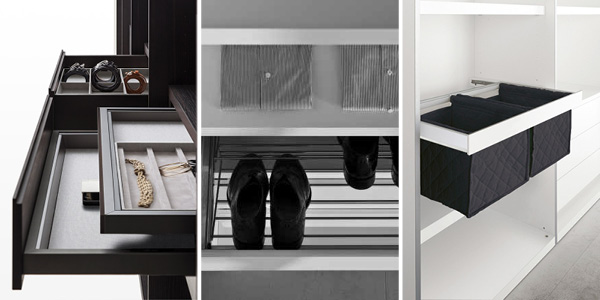A custom walk-in closet isn’t about resale value—it’s about having a space that’s perfectly designed for you.
When it comes to custom closets, a poorly designed closet costs the same to install as a well-designed closet. The difference is how you use the space. And while quality closets are seen as a plus in the real estate market, creating one isn’t about resale value, it’s about having a closet that perfectly meets your needs.
Wall closets or reach-in closets are the most common type of bedroom closet. The minimum depth for a wall closet is 24 inches and the length of most closets is around 60 inches. Walk-in closets don’t necessarily take up more square footage than a large reach-in closet, but they do require a different shape space. Either way, whether you have a walk-in or reach-in closet, the space should be designed to your needs.
Here are a few important things to consider before you design, or redesign, your closet.
Consider your space
If you’re renovating, is your current closet big enough? Would it be worth it to sacrifice some additional space to the closet? The benefit of a well-designed closet is that you likely won’t need a traditional dresser, which frees up square footage in the bedroom. If you don’t already have a walk-in closet, another option is to convert an adjacent room.

Get organized
A well-designed closet maximizes space. Before you design a new closet, you’ll want to take inventory of your clothing, group like items together, and even donate pieces you don’t wear anymore. Once you know what you have, make a list of the number and variety of spaces you need. Do you have more long items than short? Do you have more handbags than shoes? What other types of items do you have?
In order to design a closet that’s perfectly suited to you, you need to know exactly what you have and what type and size of storage space those items require.
Sharing a closet
A closet designed for him and her is more than just having separate sides. Men’s shirts are normally longer than women’s blouses and rods should be hung appropriately. One partner may prefer to hang their slacks straight while the other hangs them with a fold. Men typically have cuff links, ties, belt buckles, pocket squares, and watches, while women need space for handbags, scarves, jewelry, and hats. These items all require different size and types of storage spaces.
A closet also doesn’t need to be split evenly. Since you’ve already taken inventory of what you have, you’ll have a better idea of how much space each partner needs.
Ergonomics matter in your closet, too
A well-designed closet allows you to reach all of your clothing with ease. Open shelves are best placed at waist height so it’s easy to see what you have. Drawers can be placed underneath. Socks, underwear, and accessories should be in higher drawers and little-worn items can be drawers toward the floor. By designing your closet so that every item has its specific place, you’ll never need to reorganize because your clothing, jewelry, and accessories won’t have any place to go.

Limit drawers
Everyone needs some drawers, whether it’s for small items, jewelry, or lingerie and socks, but other items, like sweaters and t-shirts, are better stored on shelves. The benefit is two-fold: shelves take up less space than drawers and you can more readily see what you have, giving your closet a retail-like look.
Get your shoes off the floor
Just because shoes are for our feet doesn’t mean they have to live on the floor. There are a lot of creative, space-saving, more convenient shoe storage systems than shoving them under your hanging slacks. Like with handbags and other small accessories, shoes are best stored at mid-height where you can see them. You may opt for simple shelves, or you could choose pullout shelves—shoes only require about 12 inches so if you store them on shelves above deeper drawers, you can use a pullout shelf system to maximize the space.
Luxury additions
Your closet doesn’t have to stop at holding clothes. There are an infinite number of other features you could include if you so desire. Imagine valet rods that pull out to hold clothing pieces pre-selected for packing, custom LED lighting that can mimic daylight or evening light for putting on makeup, a cooler to hold perishable cosmetics, or even an espresso maker to help you get your day started. Everything is possible—it’s all up to you to decide what you need.



